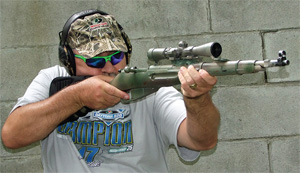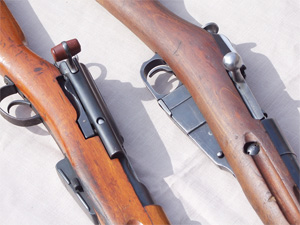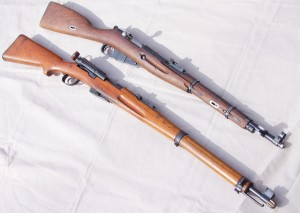by Scott Smith | Contributing Editor
I have been shooting and hunting since I was 12 years old; that was a long time ago. Growing up in southwestern Pennsylvania I had the opportunity to shoot many real Kentucky/Pennsylvania long rifles that were 200 years old. My god father’s father-in-law was one of the period’s finest rifle smiths and custom built rifles using Mauser and Enfield actions.
These rifles were hand built works of art. What stuck in my mind was these rifles started life as military rifles and they were turned into works of art for hunting.
Fast forward from my youth to today we see shooters and hunters are searching for ammunition and affordable firearms/ammunition combinations for recreational hunting and shooting. While walking the aisles of the 2014 SHOT Show, I noticed Century International Arms (430 S. Congress Ave. Ste. 1, Dept. TGM, Delray Beach, FL 33445; phone: 800- 527-1252; online: centuryarms.com) had a number of vintage bolt-action rifles. Seeing Mosin-Nagants of various makes and models as well as Swiss Schmidt-Rubins, I recalled my best friend talking of how he has turned these and a couple K98 Mausers and a few Schmidt-Rubins into “scout rifles,” aka truck guns. For those not familiar with the term “scout rifle,” this is a rifle built to be fast handling, with easily acquired/accurate optics, and in a caliber suitable for hunting big game.
This style of rifle was the brain child of Col. Jeff Cooper, who felt this style rifle would bridge the light carbine and precision rifle.
The more I handled Century’s vintage rifles, the more I thought of what it would take to turn these retired warriors into useful hunting rifles, without breaking the bank. Discussions with the crew from Century assured me their rifles were in good shape and they should be good for what I was looking to use them for. They also assured me there was plenty of military surplus ammunition available.
The question was, is there ammunition suitable for hunting available? Since I was at SHOT Show, I could check with a few of my favorite ammunition manufactures. The good news was there are several offerings of ammunition in 7.62X54R and 7.5X55 Swiss that are suitable for hunting. I would just need to research availability and procure some.
Before we go any further, I will answer the question I know many folks are asking: why these two calibers and not another? First, range ammunition is inexpensive and if you don’t reload that’s a good thing. Second for hunters, commercially available loads for these cartridges are very similar to the .30-06 Springfield which has been and still is one of the dominate rounds for hunting.
Third and to shooters, an important fact, premium ammunition is available and less expensive than traditional hunting calibers.

Author’s initial testing of the Type 53 Mosin-Nagant. Notice lack of muzzle rise; for a .30-caliber rifle it is very soft shooting.
After a few emails, a Chinese Type 53 version of the Mosin-Nagant and a Schmidt-Rubin 1911 were on the way to my FFL from Century International Arms. The rifles that arrived were in excellent condition considering their ages; the Type 53 was a late 50s carbine and the K1911 was built around 1915. The actions on the rifles were smooth and headspaces were a go.
The Type 53 is a Mosin-Nagant style rifle; straight pull bolt, a five-round integral magazine which is hinged to remove cartridges, side-folding bayonet (which can easily be removed) and rugged easily adjustable leaf sights.
The bore of the rifle while dirty, looks virtually new. From the stiffness of the bolt and trigger, lack of wear on the bolt face and crispness of the barrel’s lands and grooves, it’s a good bet this rifle has seen little range time.
The stock is most likely Chu-wood, a native wood to China. This stock was not heavily oiled, nor was it dinged or chipped; it shows the wear one would expect of a well-used garrison rifle.
When I removed the locking bands and action screws, this was confirmed by all the Cosmoline in the forearm and all around the action. Some brake cleaner made short work of all this gunk on the barreled action and the forearm. Cleaning the trigger made it comparable to many value priced modern hunting rifles. For a rifle that can be purchased for $130-160, the Type 53 should do well as a modernized hunting rifle.
Initial inspection of the M1911 Carbine, revealed a rifle that was in great shape for being nearly 100 years old. The trigger was smooth as glass, better than most any modern rifle I have shot. Researching these rifles I discovered that quality triggers are standard for Schmidt-Rubin rifles.
The bore was clean and the rifling crisp. The stock is either birch or walnut and is in excellent shape. Schmidt-Rubin rifles operate with a true straight pull bolt and this one operates smoothly and quickly. These rifles have a removable five-round box magazine; however, this one was stuck in the magazine well; no doubt time and grime were the culprits. A few shots of aerosol lubricant cleaned out the catch and the magazine was removable.
The rest of the rifle was as clean as any basic training rifle I have seen.
For safety reasons, if you purchase a Schmidt-Rubin rifle, verify what 7.5X55 Swiss cartridge is safe to operate in your model. Many of the curios (1905, 1899/1900, 1896, 1897) will not be able to handle the GP11 and current loads of this cartridge. If you are purchasing from a reputable dealer/ wholesaler, they should be able to tell you this. You will find these rifles selling for around $450.

Both rifles have large bolt handles making them easy to use when wearing gloves; M1911 on left, T53 right.
Once it was determined that these rifles were safe to shoot, it was time to take them to the range. Our initial testing would be done with bulk Russian 7.62X54R full metal jacket and 7.5X55-GP11; both are military surplus rifles could shoot with their military leaf sights before more time and money went into making these vintage rifles into scout rifles for hunting.
This pair of rifles shot quite well for having military sights. Military sights are designed to allow the shooter to be able to hit a man-sized target at 100 yards and generally four-inch groups are acceptable. Even with my aging eyes the Type 53 and Schmidt Rubin easily fired five-inch groups, right out of the box. Before the readership gasps, these sights are barely post and notch sights and with my well over 50-yearold eyes; seeing the front sight gets challenging. For what I had planned for this pair of rifles, five-inch groups with military surplus ammunition was a good starting point.
While on the range I made a couple of observations with these rifles. First, my sample Type 53 was fired very little. During initial firing the action was quite tight, especially with Russian steel-cased ammunition. The more I fired the rifle (100+ rounds) the action loosened up. This very stiff, tight action is common to the Mosin-Nagant style rifle; there are reports of Russian troops beating the action open during fighting in WWII. Later range testing with coated and brass cases would show the action is much smoother than with surplus fodder.
My observation of the M1911 was how fast it could be reloaded. The straight pull is wicked fast and you can shoot this rifle as fast as many modern pump or lever action rifles. I caution shooters not to have their face near the ejection port when operating this rifle; it ejects spent cartridges with great authority.
Having determined that these rifles performed adequately, it was time to procure optics, mounts and ammunition for them. Since these were military rifles; a cheek riser would be needed to give the shooter better eye/ optics alignment. For shooter comfort a better recoil pad would be needed too.
To solve all of these issues, I turned to Brownells (200 S Front St, Dept. TGM, Montezuma, IA 50171; phone: 800-741-0015; online: brownells.com), BLACKHAWK (6160 Commander Pkwy., Dept. TGM, Norfolk, VA 23502; phone: 800-379-1732; online: Blackhawk.com), Safariland/B-Square (3120 E. Mission Blvd., Dept. TGM, Ontario, CA 91761; phone: 800-347- 1200; online: safariland.com), and S&K Mounts (70 Swede Hollow Rd., Dept. TGM, Sugar Grove, PA 16350; phone: 814-489-3091; online: scopemounts.com) for all the accessories. All of the items we chose for these rifles are installable by the end user to keep the cost as low as possible.
The first items from Brownells were optics; a pair of Hi-Lux 1-inch tubed 2-7X32 Long Eye Relief Duplex scopes.
These will mount over the receiver, giving the shooter fast and accurate target acquisition and are variable power so you can make short fast shots or precision shots. With a retail of $129.99, these optics are a good bang for the buck.
While on the Brownells website, I ordered a pair of slip-on Kick EEZE pads. This item has since been discontinued and I suggest either Beartooth or Pachmayr Decelator pads.
Size small in all of these will fit most vintage military rifles. You will find they work well and slip on in seconds.
On average slip on recoil pads will set you back about $30.
To mount the scopes, for the Type 53 rifle I picked B-Square’s 18522 base, which retails for $29.95 with rings.
For the M1911, I used S&K’s Weaver Mount; you will need to purchase rings.
These scope bases replace the rear leaf sight and are secured via screws which replace the leaf spring pin and a lock that rides in the dovetail of the sight base.
The last piece of equipment to convert an old infantry rifle to a scout rifle for hunting is a cheek riser. Some folks will tell you this is not needed, but these rifles were designed for iron sights and optics will set up a good inch to two inches higher, which will give you a poor cheek weld. Install a cheek riser, you won’t be sorry! I chose BLACKHAWK’s Urban Warfare for the Type 53 and Rifle Cheek Pad for the M1911. Both install in moments and for me gave perfect eye/scope alignment.
They also worked well on my best friend’s Mausers and Schmidt-Rubins.
Once all the accessories arrived it did not take long to install them on the rifles. The exception was the B-Square mount which I stripped the threads on.
B-Square uses fine threads and they were easily over-tightened. There was still enough thread to keep the mount in place, just not stable. That problem was solved with Acraglas to glass bed the mount. While it’s not standard practice, glassing the scope mount will ensure the mount is secure; albeit “forever.” Once the Acraglas dried, the B-Square was solid as a rock; as you can see in the photos, I took no chances with the mount shifting, and glassed the entire mount.
S&K’s mount for the M1911 fit like a glove. This mount uses more robust screws than the B-Square and there were no issues with stripped threads.
The design of the sight of the M1911 and its siblings is such there is a groove under the leaf sight and S&K supplies a nut that slides under the groove to secure the sight. From the initial fitting the S&K mount was rock solid.
To ensure the set screws don’t work loose add a drop of thread lock to the set screws. I also suggest calling S&K if you are putting a scope on a military rifle, the different variants of rifles may require a different mount. I say this because even though S&K makes a mount for the M1911, we had to use their K31 mount; apparently my rifle was a transitional rifle and had the K31 rear sight.
Once the rifles were equipped with cheek risers, recoil pad and optics, I finished them with Duracoat (3601 129th St., Dept. TGM, Chippewa Falls, WI 54729; phone: 800-837-6677; online: lauerweaponry.com). This is a two part spray finish available in a number of colors from traditional camo colors to the wildest of pinks. I simply sprayed the rifles with a number of woodland colors to break up the outline and give them a unique look. If you have the patience, the wood on these rifles can be stripped and refinished to make them look like furniture. I don’t have the patience for this; however, I have seen my best friend’s vintage rifles he spent many hours on; they look amazing.
Even the Hi Lux LER scopes were camouflaged. These optics proved to be ideal picks for the Type 53 and M1911.
The six- to seven- inch eye relief is perfect for a scout rifle and the ¼” at 100 yards adjustments were positive.
The scopes arrive with flip up covers for both the scopes; a nice feature, especially considering these scopes retail at $130. Both rifles zeroed without any issues. Once the scopes were zeroed, snap shots at 20 yards were easy as can be and accuracy at 200 yards was excellent. Both rifles shot sub two-inch three-shot groups shooting seated, the slats of the fence on the range for support. These rifles consistently fired three-shot groups with premium and military surplus ammunition. While this may not be the accuracy of a modern bolt rifle with a traditional rear mounted scope, these rifles will serve the purpose of accurately, placing fatal shots on most big game hunted for sport and food here in the US.
For accuracy testing of the Type 53 I used Prvi-PPU 150-gr. soft point and Hornady 150-gr. SST ammunition. For the M1911, 174-gr. soft point Prvi-PPU and Graf&Sons Hornady 169-gr. A-Max was used. All of these loads are boxer primed brass cases, and are reloadable; there is a plethora of data for each caliber available.
You may ask what other varieties of hunting ammunition are available for these rifles. A quick search of one of the largest online ammunition information sources, ammoseek.com, found soft point from Hornady, Wolf and Prvi- PPU and Hornady A-Max ammunition for the M1911. For the Type 53 we found offerings from Wolf, Prvi-PPU, Winchester and Hornady.
I thought once the rifles were zeroed and camo finished I was finished with them, but I was wrong. When I had the rifles out for one of their range sessions, one of the club members told me, the Type 53 could be improved further; by adding a new trigger assembly from Timney (2020 W Quail Ave., Dept. TGM, Phoenix, AZ 85027; phone: 866-484-6639; online: timneytriggers.com). He had installed a Timney on a Mosin-Nagant and it vastly improved the rifle’s performance. Unlike the military trigger, this assembly has a safety; making this a safer and more user friendly unit. A quick check with Timney confirmed their trigger will fit the 53 and it will require fitting. A few days later, a three-pound trigger arrived. If you are not comfortable using a hand grinder on your rifle’s stock, I would have a gunsmith install this part.
With the new trigger, the 53’s groups shrank on average of a half inch, so this $103.95 part is worth installing.
While you will not find dozens of loads for these calibers like you do for traditional hunting calibers, there is a good variety available. The Schmidt-Rubins have become somewhat pricey.
They are fine rifles built with Swiss precision, accuracy and the straight pull functions in the ice and snow, but the rifle is worth it. These rifles, unlike modern rifles, are built to handle some of the worst conditions in the world and function with minimal care. This makes these rifles ideal for hard use by those who need a ranch, range rifle or rifle for extreme conditions. Out of the box these rifles are usable, and can be turned into a fine modern rifle over time, so you do not have to hurt the budget. The next time you are perusing the racks of vintage rifles at a gun show or at your local gun shop, don’t overlook the Chinese Type 53 Carbine and the Schmidt-Rubin M1911; you may overlook a diamond in the rough. When you are out hunting, be safe, wear your hi-visibility orange, know your target/ background and have fun.




